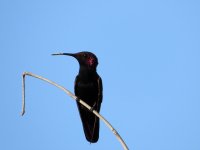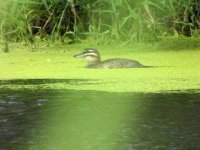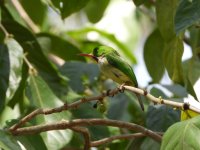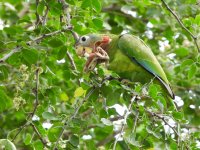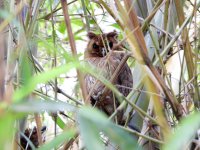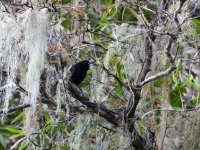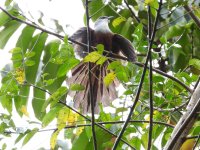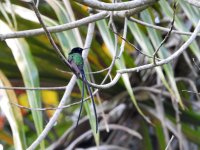lgonz1008
Well-known member

If you are an international birder, the Caribbean is a contrasting jewel of specialties that is only outdone with some of the outlandish number of endemics found in the hundreds of islands in Indonesia. Each of the major Caribbean island is home to over a dozen endemic species and have a representative endemic bird family or two. Jamaica decided to take up this challenge in spades by being the second smallest of the main islands, yet somehow being home of 28 endemics, a couple of potential splits and some sought-after rarities that are not easy anywhere in their range. The trip gave me and two friends an overall total of 105 species within 3 days of proper birding, that included most of the specialties previously mentioned with the exception of West Indian Whistling-Duck and Plain Pigeon (as both of these species are found further west in isolated pockets of the island). A huge thanks needs to be given to Ranger Lyndon Johnson (email here) who was a resourceful wealth of knowledge and driver during our birding time in the island.
It should be noted that birding this island is pretty straightforward if you know the overall sites and targets, especially since eBird does not list any of the crucial targets of the island as sensitive and we could easily change our itinerary to target these species. Driving is a bit hazardous in parts of the mountains (with trucks and other vehicles sharing the winding roads with you) and a bit of a lunatic's game when driving around Kingston, but nothing you wouldn't see while driving elsewhere in the world. Lodging was booked prior through our own methods and most Jamaican stores/restaurants accept the US dollar, but the conversion rate is all over the place and outside of one restaurant that got really close to it, most times you were losing some money if you had no Jamaican currency (highly suggest going to an ATM if you have the time and are choosing to do this trip on your own).
Detailed Itinerary:
It should be noted that birding this island is pretty straightforward if you know the overall sites and targets, especially since eBird does not list any of the crucial targets of the island as sensitive and we could easily change our itinerary to target these species. Driving is a bit hazardous in parts of the mountains (with trucks and other vehicles sharing the winding roads with you) and a bit of a lunatic's game when driving around Kingston, but nothing you wouldn't see while driving elsewhere in the world. Lodging was booked prior through our own methods and most Jamaican stores/restaurants accept the US dollar, but the conversion rate is all over the place and outside of one restaurant that got really close to it, most times you were losing some money if you had no Jamaican currency (highly suggest going to an ATM if you have the time and are choosing to do this trip on your own).
Detailed Itinerary:
- March 14-15 (Flight to Kingston and birding around the capital)
The trip began with a short and relatively painless flight to Kingston from the Miami airport. Once in Jamaica, we managed to pass extremely fast through immigration, only to be greeted by the slowest baggage carousel we've seen in our lives. From there, a quick pickup took us to our main base for the trip, a nice Vrbo home in one of the nicest neighborhoods of Kingston. From there, my friend who booked the place was taken through a tediously detailed rubric of how the house works by the owner, while we unpacked in our rooms and enjoyed dinner. The only hiccup of the night was a problem with opening one of the luggage bags as the lock became faulty and it was a fun game of finding the right person to get some pliers and break the lock.
Early the next morning, we met up with Lyndon, who would be our guide and driver for the following 3 days and a great company all around. The first stop of the trip were in the well-known (for birders) Hellshire Hills, we walked the Parochial Road and managed to connect with nearly 40 different bird species, these included the main targets of the region Stolid Flycatcher and Bahama Mockingbird, but we also managed to see a good set of endemics like Jamaican Mango, Jamaican Oriole, Yellow-shouldered Grassquit, Sad Flycatcher and Jamaican Vireo, the first three being really attracted to the flowers and fruits from the cacti that dotted the landscape. This was also the only site that we encountered White-collared Swift and (Caribbean) Cave Swallow, and our only mammal of the trip, the horribly invasive Small Indian Mongoose.
From there, we moved to our Westernmost point of the trip with the goal of seeing a widespread but always difficult, Masked Duck. The name of the hotspot on eBird is simply listed as Masked Duck Wetland, but in reality it's a set of retention ponds by a chicken farm that seem to be one of the main makeshift wetland areas of the region. Outside of the highly sought-after Masked Duck (which we saw four of them), the area was also the only site we had wintering waterfowl like Blue-winged Teal, Northern Shoveler, American Wigeon and Lesser Scaup throughout the trip, we also had a single (White-shielded) American Coot, Northern Jacana and a flyover flock of wintering Northern Rough-winged Swallow.
Our final stop before lunch was in the Caymanas Reserve, this is an unmarked roadside trail that had more cows than birds at times, but it is worth noting that this forest habitat was good for a variety of forest species, even in the midday heat. Some of the standouts of this quick stop was our first Chestnut-bellied Cuckoo, Jamaican Tody, Jamaican Woodpecker and Rufous-tailed Flycatcher; it was also the only place we saw Solitary Sandpiper in a roadside canal, and it was interesting coming to terms with how widespread and common Red-tailed Hawk is in the island.
After a quick lunch break in the Jamaican chain of Tastee Patty, we moved to Hope Botanical Gardens for our final stop of the day. Almost as soon as we parked, one of our first targets were heard squawking above us in the form of Yellow-billed Parrot and on a nearby branch we had our first of five roosting Northern Potoo for the trip around the gardens (Lyndon's new personal record). For the next two hours, we simply walked around the gardens hoping to connect with other easy regional endemics to narrow down our target list in the mountain tomorrow. Some of these included the Zenaida Dove, (Jamaican) Olive-throated Parakeet, Antillean Palm Swift, Vervain Hummingbird, (Cuban) American Kestrel, Loggerhead Kingbird, White-chinned Thrush, Greater Antillean Grackle and Jamaican Euphonia. However, the standouts resulted in Lyndon doing a happy dance by a bamboo patch as we saw a day roosting Jamaican Owl (second time Lyndon had one in the gardens) and two pairs of the sadly endangered Black-billed Parrot, the birds around the garden could have dubious origin as the nearby zoo has them in their collection, but we would eventually connect with these beauties later in the trip, so no harm in seeing them in multiple places.
Our final stop of the day was at the Vrbo, where we just relaxed in the backyard as we reconnected with a few of the birds seen on the way to their roost sites, but we also had our first views of Red-billed Streamertail as it foraged in the flowers closest to us in the fading light. Tomorrow was going to be our longest day and we were tired of all the walking done in the hot Jamaican sun, so after a quick and delicious Chinese dinner, we called it a night.
Last edited:





